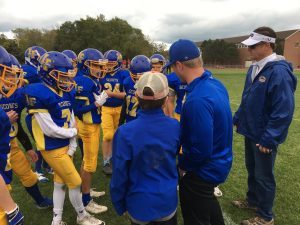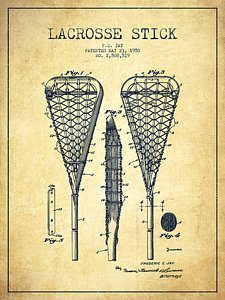Jon J. Kerr's Blog, page 2
November 8, 2017
Lessons From A Losing (But Mostly Winning) Youth Football Season

A NFL Hall of Fame coach named Bill Parcells invented a famous phrase used quite often in team sports.
When asked one season about the state of his team, Parcells said, ‘you are what your record says you are.’
This statement is true of professional and college programs (and to many respects, high school). I choose not to believe it so of youth football. If so, our 2017 Jr. Scouts 7th and 8th grade lightweight football season would be deemed a failure. We were 2-6 after all.
But the season was anything but a failure.
Let’s be clear about what this essay is not. It’s not exposition and platitudes about the unencumbered joys and graces notes of coaching 12 and 13 years old boys in football. That would be dishonest.
Here’s what this essay is: musings on the ups, downs, zigs, zags, twists, turns, baffles, befuddles, stupefying, mystifying…
and…
delights…raptures…hilarity…euphoria…cheers…charms…
All of it. Coaching youth sports, you feel all of these emotions. Often on the same day.
And as a tribute to one of our players, 7th grader Harry Capstick…all of it and a bag of Goldfish crackers.
###
“If I swallowed these would I die?” Harry said, while inhaling a handful of Goldfish crackers after practice one night.
“They aren’t real goldfish,” I said.
“What if they were?” Harry said.
“Then you might have a problem,” I said.
###
I’m not a parent. I have nine nieces and nephews between the ages of 1 and 24. I try and take an active role in all of their lives. With some–like my 14-year-old nephew who is a terrific soccer player, or my 10-year-old niece who lives down the road from me–it’s easier than others (four of my nieces and nephews live in another country. Thank God for FaceTime). What I hope they know is that I am an adult figure in their lives they can trust and will not ‘parent’ them (they already have a mom and dad).
I try and take the same approach with coaching. Be another male figure the boys can talk to about whatever (although ‘whatever’ can be dicey at this age, as I learned this year. Ha). Most importantly, I want to be someone they know is on their side and is investing time in their success.
We had an awesome blend of coaches this year. Charlie DeYoung is our head coach, a young guy who knows football and brings an energetic, spirited yet firm vibe the boys respond to. Jim Oberheide is a veteran youth coach who understands the game at a macro and micro level and is always thinking through situations and communicates in a calm, steady manner. And Frank Pinn, a Mount Carmel and Notre Dame grad who played for Lou Holtz. Another football guy who brought a tough, earnest and honest style the boys respected. And for the limited time he could coach, Andy Clifford, former LFHS and Drake University quarterback, was a huge asset. All terrific guys and we shared a strong camaraderie.
Both Jim and Frank had sons on the team this year…and I know how cool that must have been for them to spend that time with their sons. I learned a lot watching them and how they interacted with Frankie (Jim’s son) and John (Frank’s son). Bottom line…no favoritism. When necessary, they were as hard on them as any of the other players.
###
Full disclosure: one of the reasons I wanted to coach this season was to either affirm or reverse doubts I had about the safety of the sport at this age level. I am a reporter in my day job and I have interviewed mothers of sons who are adamantly against the sport as it is currently constructed for boys under the age of 14. I respect those concerns, some of which are backed by solid scientific data (and personal experience).
Anytime we are dealing with minors, a contact sport and the human brain, all stakeholders–organizers, coaches, parents–have a responsibility to encourage continual studies as it pertains to safety. And any findings resulting from research should be parsed through and analyzed.
How can we make the game more safe for our players? Seeking answers to this question is in my opinion the single most important directive for the sport in the near future.
I have to say, this season did not completely reverse my doubts. But the experience was more an affirmation on the merits of the game than its faults.
###

Here’s what makes football both exhilarating and confounding: it’s 11 on 11. Not 5 on 5, 8 on 8, or 1 on 1.
11 on 11.
Cue up Bart Simpson sound effect.
The main source of our frustrations this season was grounded in this reality: we could not get 11 boys to do their job on each play with a high level of consistency.
Hey, we all get it. It’s hard. Our team does not own the market on such behavior. Have you watched the NFL this season? And that game is played by grown men who are paid handsomely for their services. Yikes.
We have limited practice time and a low number of participants. We did the best we could considering the circumstances.
And most often, those circumstances were marvelous.
###
When I read a story by John Grisham, E.B. White, or even Gillian Flynn, something stirs inside.
Behavioral psychologists call this “unknown knowns.” They are things we as individuals know deep down in our souls but can’t always articulate. We just know it.
A year, five years, 10 years from now, when the memories of this season have faded, I’ll hold onto these “unknown knowns”:

Jack Carrabine: relentless
Jake Kroner: durable
John Pinn: allegiance
Dylan Burns: determination
Andrew Lyon: unbending
Jackson Sommers: persistence
Quinn Garrigan: sturdy
Ben Ephraim: unifying
A.J. Ellis: unflinching
Robert Pasinato: tenacious
Frankie Oberheide: unshakable
Drew Washburn: clever
Rocco Caputo: responsible
Colin Burton: dependable
Harry Capstick: loyal
Jake Clements: rugged
Alexander Domittner: joyful
Mikey Gray: intelligent
Sam Larson: intuitive
Stephen Sinclair: devoted
###
My hope–the same sentiment is shared by the other coaches–is that all of the boys continue to play the sport. That is ultimately the job of a youth coach…prepare them for the next phase. Their passion for playing the game with each other was evident all season.
It was our pleasure to coach them. We hope to do it again next year.
###
“Do you have a wife?” Harry asked me one day before practice.
“Nope. Came close once,” I said.
“Do you have kids?” Harry said.
“Nope. Just a bunch of nieces and nephews,” I said.
“I’m going to have a wife,” Harry said.
“Great,” I said. “What will she be like?”
“I don’t know coach,” Harry said. “Can I play running back?”
###
Best,
Jon (Coach Kerr)
June 13, 2017
The Coaching Diaries, Part 6: Requiem For A Season
Charlie and I took a sail on his boat Saturday on Lake Michigan (an actual sailboat…ask him about it sometime).
High winds made for choppy seas so we came in a bit early. As the afternoon sun shrunk over western skies, we popped open a few adult beverages, toasted the season, and talked for a bit.

“What did you think about the season?” Charlie asked.
I paused for a few seconds. I knew what I wanted to say.
“I thought it was great,” I said. “An unexpected joy.”
Saturday was a real physical and mental test. Yes, the boys made the league championship game. Yes, they won two close games just to get there (the semifinal win vs Rockford may be a season highlight). Yes, they did all of it on a really hot day. And yes, they ultimately lost in our league age group title game.
All of this is a good dress rehearsal for adulthood (and they had to meet the challenge without the aid of whiskey or wine).
But when thinking about writing this post over the past few days, the word that kept popping up into my head is this: devotion.

There was Charlie, our head coach, running players in and out, making sure every kid got a chance to play. Not an easy task but Charlie makes it work.
There were the moms, having oranges ready for consumption and making sure the boys were hydrated and at the fields on time.
The dads, offering food and support. Their presence Saturday was awesome to see.
And our boys. Wow. This clip reflects their camaraderie…
http://jonjkerr.com/wp-content/uploads/2017/06/Murf-I-believe.m4v
They may have believed, but they played lacrosse with with an obedience and fidelity to each other that they aren’t quite old enough to fully comprehend. I hope the time they spent together this spring carries with them as they grow and mature into young men.

So that’s what’s been on my mind these past few days. And that’s what I will remember most about this season. Small acts of devotion from everyone—moms, dads, players, coaches—that add up a youth sports experience that was truly an unexpected joy.
Have a great summer!
June 8, 2017
The Coaching Diaries, Part 5: Case of the Collywobbles
My grandmother had a word she used when she was feeling a bit off, not quite herself. Not physically sick per se, more a clairvoyant state of mind. When the ambience in the room was not atmospherically pleasing to the senses, she felt it and became slightly tense, unbalanced.
“I’m starting to feel it,” grandma Katherine would say. “A case of the collywobbles.”

I never really understood what the word ‘collywobble’ meant—all grandparents have ancient nouns and verbs passed down from their elders that are both funny and mysterious—until I got older and found myself in similar circumstances.
We had a bout of the collywobbles on a recent Saturday (May 20).
It was cold, rainy and very early. 9 a.m. game. Scarcely enough time for a Starbucks run (drive thru only). We were down a few guys. We had a referee who looked like a love child of Woody Hayes, the old Ohio State football coach, and Eleanor Roosevelt, the former first lady. I think he may have played lacrosse at Syracuse with football legend Jim Brown (fact checking this one…will report back). From the start, he called the game with a heft and preponderance I was unaware existed in the glorious game of lacrosse.
There were plenty of excuses to be had. From us coaches, from our players.
Then the jabbering started.
I was standing on the sideline when Kirby, one of our midfielders, had this dialogue directed towards him from an opposing player:
“Do you want to go! I’ll fight you right now! Right now!” said the player from the Penguins, a team from Palatine.
Kirby smartly walked away and did not respond to the chivalrous request.
During a time out between the third and fourth quarters, the morning rain showers now transformed to sleet, the Penguins coach approached Charlie, our head coach, and I.
“My guys are saying your guys are cussing at them,” the coach said.
Hmmm. What’s a tactful response to said accusation?
To be fair, we had built rapport with the Penguins coach during the game. We bonded over the shared misery of the day’s weather and the equally peculiar officiating calls (bizarre on both sides). He seemed like a good dude just trying to coach his guys. Just like us.
But Charlie and I know our guys. They don’t just go around cussing at other kids for the heck of it.
Now if provoked…

“I don’t know about that,” I said to the coach about the cussing. “I do know one of your kids just challenged one of ours to a fight.”
“That’s because he’s been talking to him all game,” their coach said.
I had to stifle a laugh at the sheer absurdity of the situation.
Whatever you say bounces off of me and sticks back to you. Nah, nah, na, nah, nah.
But can you see what’s happening here? What could happen here?
Kids acting like kids (normal), adults acting like school yard lawyers (normal but…). These are situations that can quickly spiral out of control, a dress rehearsal for a viral video hashtag:
#everythingthatswrongwithyouthsports
Awkward silence is broken.
“We’ll talk to our guys,” the Penguins coach finally said. “Will you just talk to yours?”
Reason!
Admittedly, the conversation was brief. Charlie and I asked a few of the boys what was going on out there and they collective said, “they cuss a lot.”
“Walk away and don’t talk to them. Just finish the game,” Charlie and I said, believing the best response to screwball behavior is through actions on the field. Play hard and simply beat them.
 We did, winning 4-2.
We did, winning 4-2.
This group likes close games. As a coach, we’ll take competitiveness over just about any other quality and this team is collectively tougher than most teams we play. They don’t get rattled when things start to go sideways. I don’t know if that trait has anything to do with us coaches. We just create the environment and let them play. Boy do they like to play. And win.
Everyone shook hands after the game (hugged it out with the Penguins coaches, in fact) as good sportsmen do. We raced to leave the field as the rains washed away the rest of the games that day.
If Grandma Katherine were still alive and I told her the story of our day, she would have laughed and probably had this to say:
“You see what I mean, son? The collywobbles will sneak up on you.”
Indeed.
HUMOROUS (I THINK?) EXCHANGE OF THE WEEK
“Nice Target sunglasses,” Rocco said.
“I did get these shades from Target,” I reply. “Keen observation on your part.”
“Do you have any others?” Rocco said.
“I have some Ray Bans in my car,” I said, my cool status with the boys suddenly elevated.
“Did you buy those at Target?” Potato said, now joining the dialogue.
“I did,” I said. My cool status suddenly diminished.
“Why don’t you just by sunglasses at the Sunglass Hut?” Potato said.
“Because I have to pay for them,” I said.
May 23, 2017
The Coaching Diaries, Part 4: Learning to Win
“Winning is fun, fun is winning” -former White Sox manager Ozzie Guillen
When a parent enrolls their child in any athletic endeavor, it’s fair to ask this question:
“What do I want Jonny or Julie to get out of this experience?”
It’s equally fair—mandatory in fact—for a coach to ask the same question.
When both parties use the principle of ‘experience’ as a guiding narrative, the outcome should result in a positive one. And winning should be part of the equation.
On May 13, we played a game at Evanston. Good grief.

Once you get off the interstate, the narrow and oddly directional streets with rows and rows of street lights easily makes it one of the hardest cities to get to from anywhere north of say, Dempster. (the late great Chuck Berry wrote a song about traveling to Evanston titled “30 Days.” OK, maybe Berry wasn’t opining about Evanston but you catch my drift).
None of this matters except for the drive being an annoying ‘experience’ for the adults driving. For 10 or 11 year old boys, long car rides should have no impact on performance once they get out and start moving around.
What can impact performance is the opponent.
Evanston is good. Undefeated in fact. They had given up only a couple of goals before we played them. When the game started, you could see why. They played with sound fundamentals.
In youth lacrosse, that’s as simple as passing and catching the ball, securing it in the stick’s netting (or ‘pocket’) and carrying it while running down the field. On defense, they didn’t allow our middies (Murf, Ryan, Kirby and Dylan) to just run into the middle of the field for an easy shot on goal. We had our hands full.
“These guys are pretty good, right?” I asked Ryan on the sidelines.
“They’re OK,” Ryan said, keeping the gaze of his eyes locked on the field of play.

As I’ve written about in a previous post, I’m big proponent of free play. Teach athletes fundamentals, give them a sense of how they fit within a team structure, reinforce those fundamentals and structure, rinse/repeat. Charlie (our head coach) and I don’t yell a lot during games (except when we are making substitutions. Or when we slip on an orange peel…) We believe the best way for the boys to learn how to play, is to well, play (or the concept of normalizing, not constantly fixing). Provide a supportive framework, then trust them to figure it out.
In the Evanston game, they did.
Our defense held them to three goals and we got one more. The atmosphere was tense (a function of the closeness of the game) but on the field, the boys played relaxed. There was a collective belief they were going to win, the reason as simple as while playing lacrosse is fun, it’s ten times more enjoyable when you validate that pleasure by winning.
To be clear—this is youth sports. I’m not advocating victories over participation (the No. 1 purpose of youth sports). But for coaches, we see the organic growth that comes from winning (kids want to come to practice, they want to get better, they start to understand the collegial side of sports).
And that makes the vexatious drive to Evanston (another red light! Hmm…Starbucks?) so worth it.
COOL VIDEO OF THE WEEK (kind of sums up theme of post):
May 10, 2017
The Coaching Diaries, Part 3: Free Play
This spring, Jon is coaching a 5th and 6th grade lacrosse team in Lake Forest, IL. This is the first in a series of posts about his season with the Jr. Scouts
So I arrived at the practice fields five minutes early this week.
Two of our players, Kirby and Mikey, were warming up, just tossing the ball around. My instinct was to get out of the car and start telling them what to do.
“Get your stick higher, Mikey!”
“Give him a better target, Kirby!”
But I didn’t (acknowledging and suppressing potentially counter productive instinctive actions is one of the cognitive joys of adulthood). I let them play. And I believe coaches need to exhibit more of this behavior.

Structure is essential to youth sports. Boys (and girls) need an environment on the playing fields akin to a classroom. That can only happen when there are assigned tasks, verbal feedback (positive/constructive) then repetition. Lacrosse season is short—basically six weeks with two 90-minute practices a week and 1-2 games on the weekends. There’s a lot stuff to cram in. But I’m starting to think an important reason our boys are improving rapidly is because we are simply letting them play.
We won two games last weekend. The boys played well, and we looked like a cohesive team for the first time this spring.
“We made lacrosse plays,” I told our head coach, Charlie, and assistant coach Mac after we beat the Jr. Lions Saturday (May 6) a team we had lost to two weeks prior.
“Lacrosse plays” are the following:
Scooping a ball off the ground and securing in the pocket or netting of the stick.
Throwing the ball in the air (not the ground, which can cause said ball to stick to wet, grassy, muddy surfaces) to a specific target
Target catching and securing thrown ball
Shooting ball
Scoring (if all goes well:)
Repeat
Reads like a recipe, right? It kind of is, the idea being that when all ingredients mix properly, the end result is a palatable creation (not an opus…more like a pleasant middle school band concert). You know its working because your senses tell you so.

We won both games because the boys were more comfortable making basic lacrosse moves like scooping, throwing and catching. But outside the confines of those fundamental tenants of the sport, they are winning because they are embracing free play.
Each day, we practice on a field adjacent to the 3rd and 4th graders. Since the first week or so of practices, a few of our more verbose boys (that’s Murph and Ryan) asked to scrimmage the younger team.
We finally did last week. I’m so happy we did.
The experience freed them from structure. We did officiate the scrimmage, and the coach, Mark Milliman, did call penalties (sticks to the head are bad). Aside from making substitutions, us coaches were mostly silent. We trusted the boys to apply what we’d been teaching them and simply let them play.
We did the same this week (May 9).
As coaches, we try and fix things. We should spend just as much time normalizing. Playing with each other, against other competitive boys, and all the joys and anxieties that go along with that, is normal.
Minus the adult voices.

HUMOROUS (I THINK?) EXCHANGE OF THE WEEK
“Matt, you’re in!” Coach Kerr said.
“My name’s Potato,” Matt said.
“What? Did you say ‘Potato?’”
“Yes. Everybody calls me that.”
“Is ‘Potato’ on your birth certificate?”
“I don’t know.”
April 26, 2017
The Coaching Diaries, Part 2: The Art of Improvisation
This spring, Jon is coaching a 5th and 6th grade lacrosse team in Lake Forest, IL. This is the first in a series of posts about his season with the Jr. Scouts
During a media interview for Western Open Golf Tournament several years ago, men’s golfer Phil Mickelson was asked how he best prepares for a tournament.
“Practice like hell then wing it,” he said with a smirk on his face.
It’s a slogan that should be adopted by all youth sports organizations.

After two weeks of practices on rain soaked, grass fields, the boys played their first lacrosse game Saturday.
All nine of them.
You need 10 to play a lacrosse game (three attack men, three middies and three defenseman, one goalie).
So we started with a man down.
The game was played on a field turf. We hadn’t practiced on field turf. Because field turf absorbs water and rests above a drainage system (two important utilities to thrive in wet, Midwestern Spring seasons), a lacrosse ball rolls faster. Players must react more decisively, make snappier decisions. And half the kids in the line up that day are playing the first competitive lacrosse game of their lives.
As a coach, my thought is, ‘we didn’t practice for this. We won’t be prepared.’
“Did you know I forgot my stick, coach?” said Murf, one of our most athletic and free-spirited kids.
“Did you check your mom’s car?” I asked, thinking we had to scrounge up a stray stick.
“Nah, I got it. Just messin’ with you,” said a laughing Murf as he leaped onto a large cushion just off the field used for track pole vaulters. “I like it better on turf. Easier to scoop up.”
I feel better. In the 30 minutes we have for warm ups, the boys look just fine. One less player? We’ll switch a few things around. We’ll be OK.
A few minutes before the opening face off (lacrosse games start with a face off, much like hockey), the brother of one of our players walks up to Charlie, our head coach.
“Do you need an extra player? My dad is driving down now with my gear,” the boy said, also named Charlie.
We’re up to 10. A full line up.

We start the game. There are many rules in lacrosse, some involve the protection of players from bodily harm from others (using sticks as blunt force weapons, for instance. A no-no). Others are of the save-them-from-themselves variety (men can relate to these rules especially). In this category, two are about pieces of equipment that must be worn at all times:
Mouthguards
Protective cups
Midway into the game, an official asks our goaltender is he is wearing a protective cup.
“No,” says Jonathan (bless his heart for his honestly but there is a lesson to be learned here about selective candor. For another post).
The game is stopped until we can produce a cup. Or a new goaltender wearing a cup. The later is not an option. The official gives us two minutes to come up with a plan. We have no plan.
“Hey!” yells one of the coaches from the other team. “I have a spare throat guard in my bag. You can use that if you want.”
Bingo! In front of his giggling teammates, Jonathan puts the throat guard to a use for which it was never intended.
“Don’t worry, Jonathan. I’ll make sure I delete the photos,” I say to him as he sprints back onto the field.
“What???!!!” he shrieks.
“Just kidding,” I said back. “Now go out there and stop some shots!”
I’m reminded of something about 11-year olds: If it’s about them, they are not quite old enough to get the joke. It won’t stop me from making them.
A few minutes later, another stoppage.
“No mouthguard,” said the official. He’s talking about Charlie, our late free agent acquisition.
More scrambling. We find a latex glove in the first aid kid.
“He might swallow it,” coach Charlie said.
“That wouldn’t be good,” I concur. We scrap the idea.
At each game, a parent brings a tray of orange slices. For kids, the Vitamin C acts like a protein shake would for exercising grown ups. The chewed up slices are still on the tray sitting near a sideline bench. There’s only a few minutes left in the game. All we need is the illusion of a mouthpiece.
“Charlie! Put this in your mouth!” as I hand him a gnawed orange peel.
He puts it in, no questions asked. Gotta love this age.

Down a goal, we tie the game with a few seconds left. We win the face off, the ball rolls into the pocket of Charlie’s stick. He sprints towards the goal and as the clock expires, he fires a game- winning goal. We win. The boys jump up and down (us coaches do the same, avoiding a muscle pull) and celebrate what was a hard fought and, ahem, resourceful win.
We have eight games on our schedule this spring. I don’t know if we’ll have another one quite like our first one. But we might. I can’t help but think of a quote from John Wooden, the legendary UCLA men’s basketball coach.
“Things turn out best for the people who make the best out of the way things turn out.”
Sounds about right.
Do you have a story about a recent coaching experience similar to Jon’s? Feel free to share in the comment section below.
April 19, 2017
The Coaching Diaries, Part 1: Beginnings
This spring, Jon is coaching a 5th and 6th grade lacrosse team in Lake Forest, IL. This is the first in a series of posts about his season with the Jr. Scouts
It only took one hour into the first day for me to remind me why coaches coach.
I had given instruction to one of our new-to-the-sport fifth graders on how he could most improve at lacrosse.
“Hit wall balls,” I said. “Find a wall near your house.”

The idea is hardly innovative. If one were to Google ‘how to get better at lacrosse,’ nine out of the first 10 posts are ‘hit wall balls.’ (the other is grow your hair out). Considering Jack has a shaved head and grooming advice is not on the master list of required tasks to be performed by volunteer youth coaches this spring, I stuck with wall balls.
Lacrosse is a rare game in that it requires athletes hold a stick in their hands. It’s usage is actually a necessity, not an instrument for dispensing playfulness, frustration, laziness…(whatever it is a kid’s level of emotion can accelerate or decelerate towards). Nothing happens on the field if the athlete holding the stick can’t:
Catch the ball
Pass the ball
Why wall balls in lacrosse work is they teach kids how to do both. What they do is throw a lacrosse ball against a wall and catch it on the rebound in the pocket of the stick (lacrosse balls are made of rubber so balls bounce rapidly off hard surfaces). Through repetition comes mastery.
As the mechanical aspects of the game become learned, anxiety dissipates and confidence blooms. Then the fun, creative side of the brain starts to work. As a coach, when you see that emerge in a young athlete, you know they are hooked on the sport.
You know what hooks us? I was reminded the first day.

“Coach Kerr,” Jack said, as he removed his helmet at the end of practice. “I’m going to hit those wall balls you said I should hit.”
“Great,” I said. “Now to be clear…I don’t mean a wall in your house. Or the side of your house. That includes all garage doors. The key word here is near.”
Jack smiled as if my clarification was unnecessary. Not sure if he got my attempt at humor. He’ll figure out I’m a bit of a wisecrack eventually.
Then he said it again.
“Coach Kerr I’m going to do it this weekend,” Jack said. “I’m going to hit wall balls.”
That’s it. Having a kid say he wants to get better is cat nip for coaches.
Our first game is Saturday. I’ll know pretty quickly how well he follows through on what he said.
I just hope he doesn’t break any windows.
Do you have a story about a recent coaching experience similar to Jon’s? Feel free to share in the comment section below.
May 17, 2016
ICM 008: What’s it like to run a regional sports network? A conversation with Joe Collins of Comcast Sports Net Chicago
There is no doubt about what type of sports city Chicago is. It is a pro sports town. We live for our teams 12 months a year.
If a Chicago sports fan doesn’t root for one or all of our major pro sports teams–Cubs, White Sox, Blackhawks, Bulls, Bears–they certainly are interested in news about them. No one understands this dynamic better than Joe Collins, managing editor of csnchicago.com and Comcast Sports Net Chicago.
We tackle several topics with Joe on in this month’s Inside Chicago Media podcast.
You can listen below, on iTunes, or subscribe to the show using your Android or iOS podcast app.
Show highlights:
• How Joe balances coverage of the five major sports teams in Chicago; the Bears, Cubs, White Sox, Blackhawks and Bulls.
• There are times in the calendar when all five teams are playing at the same time. Decisions have to be made. On a night when crazy events took place, Joe gives an example of when he and his staff had to decide which team would be the lead story.
• Owners of four of the five franchises have ownership stakes in CSN Chicago. How does this circumstance shape coverage of teams and does it restrict how CSN practices journalism?
• Joe gives his insights on the future of regional sports programming. Will there be a bubble in Chicago?
You can visit csnchicago.com to read up on Chicago’s sports team. Joe can be found on Twitter @joecsn.
April 11, 2016
ICM 007: Covering the Chicago Cubs, Wrigleyville and Notre Dame with versatile Chicago Tribune Sportswriter Paul Skrbina
On April 11, the Chicago Cubs open their 2016 home schedule. Fans will see a different Cubs team inside Wrigley Field. And they will see a different neighborhood outside.
Paul Skrbina is as versatile a sports writer as you will find in Chicago. Paul satisfies baseball diehards with nuts and bolts stories on Cubs players and Joe Maddon’s progressive managerial moves. Interested in the Wrigley Field restoration project? Paul writes about that as well.
And oh by the way, he is the Tribune’s beat writer for Notre Dame and covers the Blackhawks.
We tackle several topics in this month’s Inside Chicago Media podcast.
You can listen below, on iTunes, or subscribe to the show using your Android or iOS podcast app.
Show highlights:
• What is going on with the ballpark at Wrigley Field and what is in store for fans on Opening Day.
• Paul spent time with the Cubs at spring training in Arizona. He gives his take on the team’s remarkable locker room chemistry and why Maddon is the perfect manager.
• Having just competed his first full year covering Notre Dame football and basketball, Paul take listeners behind the Golden Dome. What are challenges/advantages to writing about the country’s most polarizing program?
• The NHL playoffs begin this week. Paul will be on the Blackhawks beat. He explains how he was able to get a story no one else did on a well-known Blackhawks player.
• How do reporters like Paul get their stories? He lets listeners in on his sourcing and writing process.
You can read Paul’s stories by visiting his personal page on the Tribune’s website. He is on Twitter @chitribskrbina.
April 6, 2016
Boys in Brown Announcement: Speaking Appearance in Vernon Hills Tonight
Hello everyone!
One final reminder about a speaking appearance tonight at Aspen Library in Vernon Hills.
I’m very excited to be a part of a local author’s initiative started by Lake County libraries called Authors Out Loud. They sponsor appearances from local authors. This is important as it gives readers a chance to interact with authors and introduce books to new readers.
Tonight, at 7 pm, I’ll be speaking inside the meeting room at Aspen Library in Vernon Hills. The address is 701 Aspen Dr., Vernon Hills. This will be very informal. Come with questions/comments about the book. I will have copies on hand.
Hope to see some of you there!
Thanks.
Jon



